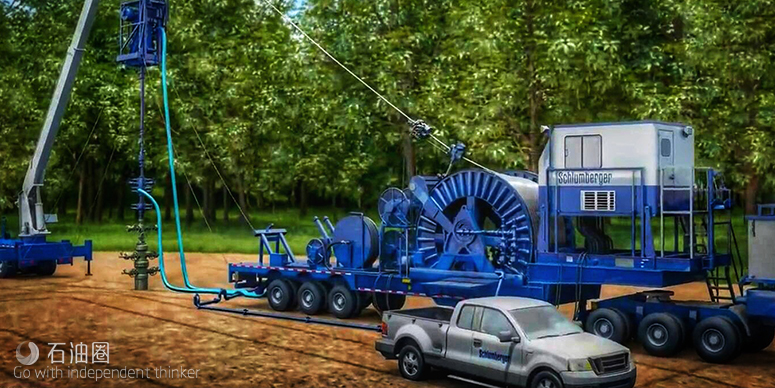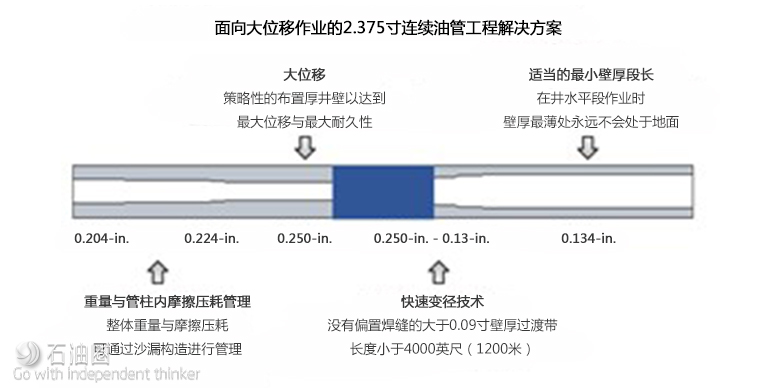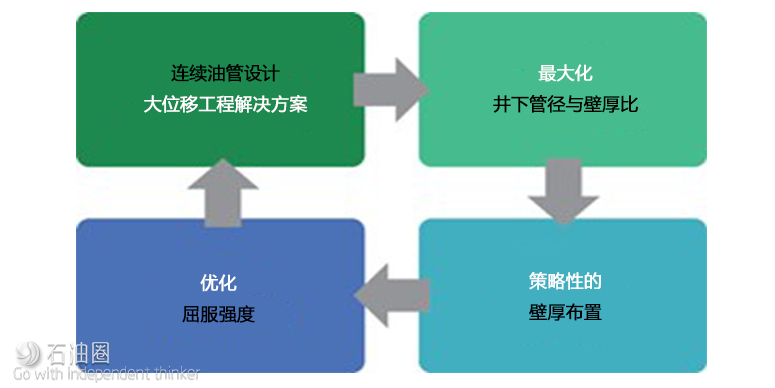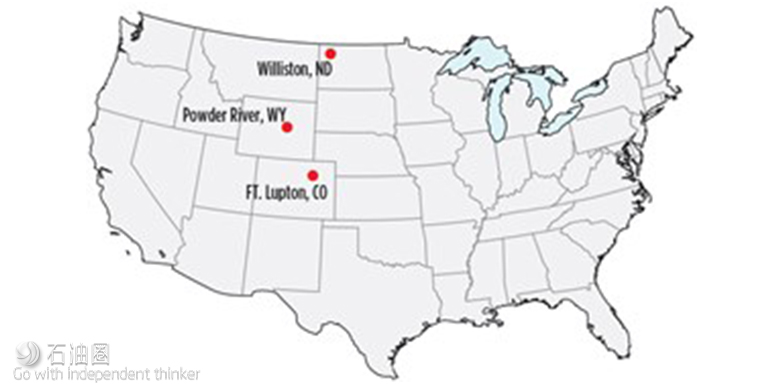Coiled tubing manufacturing technology has revolutionized CT string design optimization.
HOURGLASS CT
The latest generation of string designs is reaching unprecedented weights by using wall thicknesses and innovative configurations to enhance well lateral reach and fatigue performance. CT service companies are searching for ways to reduce tubing weight while maintaining and/or increasing string length, without sacrificing safety, CT reach or service life performance. As a response to address these challenges, “Hourglass” CT design configurations have increased in popularity.
An hourglass string configuration features a reduced wall thickness in the upper end of the CT string, which is typically not under severe stress. However, this reduced wall is selected carefully to provide enough axial load capacity to maintain safe overpull values during operations. The inherent flexibility of Rapid Taper strips allows for the manufacture of a custom-engineered hourglass CT design that maximizes reach, overpull, and fatigue life, while meeting CT surface equipment design constraints.
This new trend of string design configuration does not affect the reach capacity of the CT, if utilized properly. The main benefits for custom designed CT are:
1.Weight optimization
2.Reduced CT frictional pressure losses, due to the restricted inner diameters (IDs), caused by the extended heavy wall used to add rigidity to the string
3.Reduced overall tubing costs
Weight is the predominant challenge in extended-reach CT string designs. With this new generation of large-diameter CT string that may exceed 24,000 ft in length and more than 125,000 lb in weight, one of the critical challenges is the current mobilization weight constraints of the CT surface equipment (reel and trailer). This weight restriction limits the maximum wall thickness that can be used in the CT design, which affects the stiffness and horizontal reach capacity of that specific design.
The weight limitations can adversely affect the maximum length of the string produced. To this end, the CT service companies have to reduce the CT size and rely solely on the performance of extended-reach tools and fluid additives to reach target depths, which can hinder CT suitability for the operation.
An engineered approach to the challenge. Figure 6 summarizes the CT design methodology followed by Global Tubing that has modernized CT manufacturing and enabled service providers to support operator requirements. These design criteria have been proven to increase CT performance in extended-reach well operations, as well as increasing useable fatigue life while conforming to surface equipment design constraints.
The process starts by reducing the CT weight in a well’s horizontal section. The CT weight can be reduced by increasing the diameters to wall thickness ratios (D/t) in the downhole end, which is achieved by decreasing the wall thickness as much as possible. To retain sufficient mechanical properties, the material yield strength is increased to compensate the pressure and axial load capacity. The process continues by strategically selecting and placing various wall thicknesses along the length of the CT string, to improve bending stiffness and avoid the onset of helical buckling in the well. If necessary for weight limitations, the heavy wall thickness in the upper end is reduced as much as permissible, creating the “Hourglass” configurations.
CASE HISTORY
CT service companies working in the Williston, Powder River, and Denver-Julesburg basins (Fig. 7) collaborated with Global Tubing to engineer strings that have a reach capability of up to 10,500ft, while adhering to strict weight limitations. To this end, information provided by the CT service company, such as well completions diagrams, surveys, operational practices and CT surface equipment available, was evaluated for the development of an optimized CT string.
The custom-engineered string designs balance several factors to maximize reach while maintaining acceptable tubing weights. The manufacturer’s extended-reach CT design methodology was focused to minimize CT helical buckling in the 7-in. casing by placing specific thickness to increase bending stiffness and reduce wall contact forces. Proper selection of the thinnest wall thicknesses was based on the proper diameter to wall thickness ratio (D/t) for the CTU geometry (gooseneck, reel), to avoid being at surface during milling operations.
An hourglass configuration was employed on the CT designs to manage the weight limitations set by the CT service equipment and mobilization logistics. This was coupled with the use of dual rapid taper strips at the expected work area, to optimize fatigue life of the bias welds.
The string designs were used in their respective areas and exceeded expectations on lateral reach. The 2-in. CT design reached 9,500-ft laterals in the DJ basin, the 2.375-in. CT design reached 10,000-ft laterals in Powder River, and another 2.375-in. CT design reached 10,500-ft laterals in the Williston area. Figure 8 describes the CT-engineered solutions for the aforementioned basins.
The combination of using a custom-fit CT design, friction reduction tools and fluids additives, aligned with superior operational techniques, had great impact on economically and efficiently developing longer laterals wells in the DJ, Powder River and Williston basins.
What’s next? Longer laterals, larger completion well designs are a top priority. U.S. unconventional shale producers continue to push well lateral limits, as 10,000 ft has shown to be achievable for drilling and completion. Operators in the Bakken and Permian basin projected drilling, during 2018, extra-long laterals reaching over 16,000 ft, with an aim to increase overall oil recovery per well. The use of CT has been vetted thoroughly, and custom CTUs are being built to support the increased CT length and weight. Engineered solutions for 2.375-in. and 2.625-in. CT, with over 29,000 ft in length and 0.276-in. maximum wall thickness (highest wall thickness ever used in a working string), are in the final design stage. These strings are expected to surpass 155,000 lb in weight, becoming a new milestone for U.S. CT interventions.
CT manufacturers keep innovating. Recent technological innovation in the CT manufacturing industry, with the introduction of an in-line quench and temper process, has transformed CT interventions by producing CT with consistent steel microstructure throughout its entire length. Consistent steel microstructure adds strength to the steel while increasing the tubing resistance to fatigue and corrosion factors. This technology enables the engineering of high-profile CT strings by using greater diameter to wall thickness ratios (D/t), while satisfying pressure ratings, tensional load limits and enhanced fatigue performance.
The application of CT with Rapid Taper Strip technology, through an inline quench and temper manufacturing process, has improved the safety, reliability and profitability of CT service operations across multiple shale plays. In cooperation with operators and CT service companies, a CT manufacturer is producing highly engineered CT strings with greater resistance to deformation and low-cycle fatigue. These technologies have facilitated the advent of economic solutions for CT interventions in extreme and new extended-reach drilling projects worldwide.
The oil and gas industry has a long history of continuous innovation and technology development in support of E&P operations. As new cutting-edge horizontal drilling and completion technologies are released and utilized in the industry, CT manufacturers will continue to innovate and provide engineered solutions that enable CT to be a premium, safe and reliable technology in the toughest environments, and on the most critical projects.

 石油圈
石油圈



